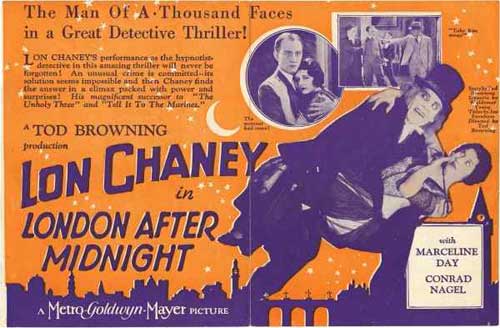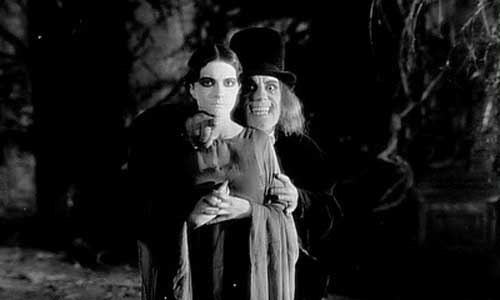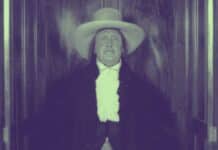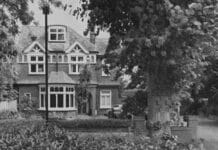BARRY McCANN discusses the most sort-after lost silent horror film, London After Midnight (1927), starring Lon Chaney
London After Midnight is one of the many silent screen collaborations between actor Lon Chaney and director Tod Browning.
Out of all of their projects, this film has since become the most legendary, mainly due to its absence. Little seen after the advent of sound cinema, it vanished completely during the 1960s when the last known copy was lost.
While film historians may mourn this piece of missing art, those with longer memories suggest its presence would probably serve only to deflate its reputation.
‘Man of a Thousand Faces’ Lon Chaney plays Inspector Burke of Scotland Yard
In the film, Chaney plays Inspector Burke of Scotland Yard, called to the house of Roger Balfour after he is found shot dead.
Burke concludes the act to be suicide, though Balfour’s executor and neighbour, Sir James Hamlin, insists his friend never would have taken his own life.
Balfour’s house stands empty for five years, before two sinister looking tenants take up residence; a bulged eyed man with pointed teeth and a top hat, and a pale young woman in a long gown (known as Luna).
Sir James is still living next door along with his nephew, Arthur, and Balfour’s now grown daughter, Lucille.
He summons Inspector Burke, fearing the strangers may be involved in Balfour’s death.
Burke remains unconvinced, until strange things start happening.
Balfour’s body disappears from its tomb and the new maid, Smithson, reports being menaced in Lucille’s bedroom by the strange man. Burke and Sir James also perceive the stranger bears a resemblance to the late Roger Balfour.

Arthur becomes convinced the neighbours are vampires, while Burke confesses to Lucille he no longer believes her father committed suicide.
After Burke is apparently wounded by a mysterious gunshot, Lucille is abducted by the mysterious stranger and the butler, and taken to her former home.
Sir James, acting on Burke’s instructions, shows up at the Balfour house and is met by the stranger, who puts him into a hypnotic trance. Arthur breaks into the Balfour house in an attempt to rescue Lucille, but is caught by Burke and a couple of detectives and locked away.
The stranger turns out to be Burke himself in disguise. Smithson, the maid, is an assistant detective, and the mysterious young woman, a stage performer working for the police.
Under hypnosis, Sir James re-creates his actions the night Roger Balfour died, revealing that he shot Balfour and made it appear suicide, after Balfour rejected his proposal of marriage to Lucille. With Sir James arrested, Lucille and Arthur are free to marry.
London After Midnight avoided the overtly supernatural
As was usually the case with Hollywood produced “horror” films of the silent era, London After Midnight was careful to avoid the overtly supernatural and conclude its narrative with a “rational” explanation.
However, the Scooby Doo ending tagged onto this tale makes no sense.
Why pretend to be vampires to lure Sir James into the house and be hypnotised? Why put Lucille through the trauma of being kidnapped? It’s all melodramatic stuff, but illogical in context.
Not surprisingly, critics who actually saw the film tend to be less than enthused by it, despite Chaney’s striking make up and memorable imagery.
As is often the case with missing gems, its absence has elevated London After Midnight to the holy grail of lost horror films.
The film may not live up to its reputation
But the consensus that the film may not live up to its acquired reputation suggests it is probably best remembered than seen.
There are many, however, who would like to find that out for themselves.
The last catalogued copy of the film was destroyed by fire in an MGM vault in 1965 and rumours of prints in private collections have circulated since. The most popular claim is that an archived copy exists under its UK release title, The Hypnotist.
Somehow, I think researchers would have considered that. And until something substantial is uncovered, there is only the 45 minute reconstruction produced in 2002 using an assembly of surviving stills put to a music soundtrack.

Another interesting aspect of London After Midnight was its inclusion in the defence case of a 1928 murder trial, in which a man accused of murdering a woman in Hyde Park claimed that Chaney’s performance in the film drove him temporarily insane.
The plea was rejected, but could one speculate if a print of the film was exhibited in court and now resides in Scotland Yard’s Black Museum? Now there is another rumour waiting to happen.
Browning remakes London After Midnight as Mark of the Vampire
Eight years after the original, Tod Browning remade the film in sound as Mark of the Vampire, switching the setting from London to Czechoslovakia and changing the character names, except for Luna.
Bela Lugosi took the role of the “vampire” now called Count Mora, while Carol Borland succeeded Edna Tichenor as Luna, proving iconic in the role of Mora’s “Bloofer Lady” daughter.
The crumbling castles and misty graveyards of Eastern Europe certainly endowed the remake with an atmospheric identity of its own.
However, Browning opted to retain the cheat ending, now inexcusable considering Hollywood were now happily churning out blatantly supernatural horror films.
So check out your attics, because London After Midnight could still be out there.
The fact that it grossed $500,000 dollars upon its initial release implies a wide distribution and plenty of prints being struck at the time.
But beware, given the film’s apparent failings, will the lucky soul finding it also become the unfortunate who drives the final nail into its legendary reputation?









